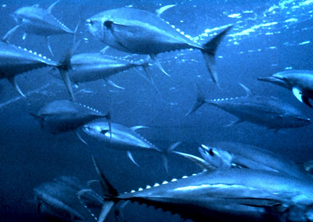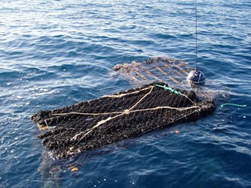Fish Aggregating Devices: Ecological Problems with a Common Fishing Technique
by Tom Tascone, RJD Intern
If you’ve seen the television show “Wicked Tuna” on National Geographic, then you are certainly familiar with some of the techniques associated with long line fishing of these species. While this is the method of choice for recreational fishermen, commercial fishermen seeking various species of tropical tuna have abandoned the traditional “rod-and-reel” technique for a far more effective tool. Known as the Fish Aggregating Device (FAD), this tool relies on the natural behavior of tuna to congregate under floating objects on the surface of the ocean. Most FADs are made from bamboo rafts in order to mimic natural logs and other marine debris that often drift out at sea, and large numbers have been deployed. Besides dramatically increasing the number of tuna caught in fisheries operations, how have the use of FADs modified the “floating object environment” in the ocean, and what effects can they have on marine ecosystems? A recent article published by Dr. Laurent Dagorn has attempted to answer these important questions.
To address these questions, Dr. Dagorn and his colleagues collected data from fisheries observers working on tuna fishing vessels in the West Indian Ocean. The data showed the total number of both natural and artificial floating objects encountered over two years of observations. The researchers then divided the West Indian Ocean into the fishing zones established by the Indian Ocean Tuna Commission, and compared the amount of FADs and natural logs in each zone. Their results concluded that the number of floating objects has nearly doubled in every zone. This is due to FADs occupying areas with natural logs and also occupying new areas previously devoid of any natural floating object. In addition, the number of floating objects in some areas even ranged between 20- 40 times higher than the numbers found before we even began to use FADs!
Although the study only focused on determining how FADs modified the natural floating object environment, Dr. Dagorn did address the potential implications these changes can have for tropical tunas. It is believed that natural logs indicate biologically productive areas, areas rich in resources needed by many tropical tuna species. If this is the case, then it is possible that this peculiar tuna behavior represents an evolutionary adaptation that helps them to remain in waters more beneficial to their growth and survival. FADs now deployed into poorer quality waters can lead these tuna away from those better areas, creating an “ecological trap” that poses a significant risk to their overall health, and the overall health of the tuna fisheries in the West Indian Ocean as well. Scientists will still need to conduct more research to confirm this idea, but Dr. Dagorn’s study has established better parameters for monitoring FAD use, parameters which can guide future studies aimed at promoting more sustainable tuna fisheries.
Reference
Dagorn, L et. al. (2012) “How much do fish aggregating devices modify the floating object environment in the ocean?” Fisheries Oceanography.






Leave a Reply
Want to join the discussion?Feel free to contribute!